Deck 35: Japan, 1333 to 1980
Question
Question
Question
Question
Question
Question
Question
Question
Question
Question
Question
Question
Question
Question
Question
Question
Question
Question
Question
Question
Question
Question
Question
Question
Question
Question
Question
Question
Question
Question
Question
Question
Question
Question
Question
Question
Question
Question
Question
Question
Question
Question
Question
Question
Question
Question
Question
Question
Question
Question

Unlock Deck
Sign up to unlock the cards in this deck!
Unlock Deck
Unlock Deck
1/50
Play
Full screen (f)
Deck 35: Japan, 1333 to 1980
1
Dry-landscape gardens became very popular in Japan during which period?
A) Momoyama
B) Nara
C) Muromachi
D) Edo
A) Momoyama
B) Nara
C) Muromachi
D) Edo
C
2
Which of the following describes a Japanese element in Hokusai's The Great Wave off Kanagawa ?
A) The background has a low horizon line.
B) The flat triangles of the wave are flattened in the foreground.
C) The wave has been colored with Prussian blue.
D) Mount Fuji is shown in receding perspective.
A) The background has a low horizon line.
B) The flat triangles of the wave are flattened in the foreground.
C) The wave has been colored with Prussian blue.
D) Mount Fuji is shown in receding perspective.
B
3
How did the aesthetics and rituals of the tea ceremony affect the design of the teahouse?
A) The interior space was elegant and fitted with silk pillows.
B) The interior space was designed after the Ise Shrine.
C) The interior space was roofless and open to the elements.
D) The interior space was dim and tiny to enhance togetherness.
A) The interior space was elegant and fitted with silk pillows.
B) The interior space was designed after the Ise Shrine.
C) The interior space was roofless and open to the elements.
D) The interior space was dim and tiny to enhance togetherness.
D
4
What aesthetic principle, developed in the late 15th century, shaped the tradition of the tea ceremony and the utensils used?
A) Song, value found in complex design
B) Wabi, value found in refined simplicity
C) Ming, value found in the technically brilliant
D) Chan, value found in rich design
A) Song, value found in complex design
B) Wabi, value found in refined simplicity
C) Ming, value found in the technically brilliant
D) Chan, value found in rich design

Unlock Deck
Unlock for access to all 50 flashcards in this deck.
Unlock Deck
k this deck
5
Who was the primary patron of Kano Masanobu, who founded the Kano style?
A) Tsutaya Juzaburo
B) Takahashi Yuichi
C) Muromachi shogunate
D) Tokugawa shogunate
A) Tsutaya Juzaburo
B) Takahashi Yuichi
C) Muromachi shogunate
D) Tokugawa shogunate

Unlock Deck
Unlock for access to all 50 flashcards in this deck.
Unlock Deck
k this deck
6
Which of the following accurately describes the aesthetic of the Katsura Imperial Villa in Kyoto?
A) Rich and complex ornamentation with elements from the Tang dynasty
B) Tastefully subtle with elements of courtly gracefulness and proportion
C) Lush and opulent with elements from the Unified Silla Kingdom of Korea
D) Stark and severe with elements of Zen simplicity
A) Rich and complex ornamentation with elements from the Tang dynasty
B) Tastefully subtle with elements of courtly gracefulness and proportion
C) Lush and opulent with elements from the Unified Silla Kingdom of Korea
D) Stark and severe with elements of Zen simplicity

Unlock Deck
Unlock for access to all 50 flashcards in this deck.
Unlock Deck
k this deck
7
Which of the following Japanese artists went to China and was able to study with Ming masters?
A) Sesshu Toyo
B) Kano Motonobu
C) Hasegawa Tohaku
D) Kano Eitoku
A) Sesshu Toyo
B) Kano Motonobu
C) Hasegawa Tohaku
D) Kano Eitoku

Unlock Deck
Unlock for access to all 50 flashcards in this deck.
Unlock Deck
k this deck
8
Which of the following groups showed the greatest affinity for Zen teachings, which emphasized rigorous discipline and personal responsibility?
A) Upper echelons of the imperial court
B) Middle-class merchants and tradesmen
C) Upper echelons of the warrior class
D) Seafaring traders
A) Upper echelons of the imperial court
B) Middle-class merchants and tradesmen
C) Upper echelons of the warrior class
D) Seafaring traders

Unlock Deck
Unlock for access to all 50 flashcards in this deck.
Unlock Deck
k this deck
9
Which school did not have a continuity of lineage in which father trained son or master trained pupil?
A) Kano School
B) Rinzai school
C) Rinpa School
D) Soto school
A) Kano School
B) Rinzai school
C) Rinpa School
D) Soto school

Unlock Deck
Unlock for access to all 50 flashcards in this deck.
Unlock Deck
k this deck
10
What is the Chinese term for the Japanese Zen ?
A) Zhuan
B) Chan
C) Zhao
D) Hoitsu
A) Zhuan
B) Chan
C) Zhao
D) Hoitsu

Unlock Deck
Unlock for access to all 50 flashcards in this deck.
Unlock Deck
k this deck
11
Which of the following describes the function of the tatami?
A) Special sliding door to exit house interior into the garden
B) Folding panel that makes two interior rooms into one space
C) Serves as a private and shaded inner courtyard in country villas
D) Flooring material put down in place of wearing shoes indoors
A) Special sliding door to exit house interior into the garden
B) Folding panel that makes two interior rooms into one space
C) Serves as a private and shaded inner courtyard in country villas
D) Flooring material put down in place of wearing shoes indoors

Unlock Deck
Unlock for access to all 50 flashcards in this deck.
Unlock Deck
k this deck
12
Which of the following describes a characteristic trait of Zen Buddhism?
A) Provided a promise of individual salvation after death
B) Promoted active engagement within wider community
C) Emphasized rigorous discipline and personal responsibility
D) Emphasized the attainment of enlightenment via worldly goods
A) Provided a promise of individual salvation after death
B) Promoted active engagement within wider community
C) Emphasized rigorous discipline and personal responsibility
D) Emphasized the attainment of enlightenment via worldly goods

Unlock Deck
Unlock for access to all 50 flashcards in this deck.
Unlock Deck
k this deck
13
The aesthetic characteristics of wabi and sabi are most evident in which artistic genre?
A) Tea ceremony
B) Architecture
C) Woodblock prints
D) Gardening
A) Tea ceremony
B) Architecture
C) Woodblock prints
D) Gardening

Unlock Deck
Unlock for access to all 50 flashcards in this deck.
Unlock Deck
k this deck
14
What is the term for an alcove used to display prized objects or hang scrolls of painting or calligraphy?
A) Tokonoma
B) Tatami
C) Nezumi
D) Engawa
A) Tokonoma
B) Tatami
C) Nezumi
D) Engawa

Unlock Deck
Unlock for access to all 50 flashcards in this deck.
Unlock Deck
k this deck
15
What technique requires the painter to visualize the image, load the brush with ink, and then create the painting with rapid strokes and some dripping of the ink onto the paper?
A) Rinpa
B) Nishiki-e
C) Byobu
D) Haboku
A) Rinpa
B) Nishiki-e
C) Byobu
D) Haboku

Unlock Deck
Unlock for access to all 50 flashcards in this deck.
Unlock Deck
k this deck
16
The rise of the Ashikaga clan in the 14th century introduces which art historical period?
A) Momoyama
B) Edo
C) Meiji
D) Muromachi
A) Momoyama
B) Edo
C) Meiji
D) Muromachi

Unlock Deck
Unlock for access to all 50 flashcards in this deck.
Unlock Deck
k this deck
17
Which school of painting style featured vivid color, extensive use of gold and silver, and decorative patterns?
A) Kano School
B) Rinzai school
C) Rinpa School
D) Soto school
A) Kano School
B) Rinzai school
C) Rinpa School
D) Soto school

Unlock Deck
Unlock for access to all 50 flashcards in this deck.
Unlock Deck
k this deck
18
With the rise of the wabi aesthetic, the Chinese objects associated with the tea ceremony utensils were replaced by which of the following?
A) Vietnamese ceramics
B) Yuan ceramics
C) Korean ceramics
D) Siberian ceramics
A) Vietnamese ceramics
B) Yuan ceramics
C) Korean ceramics
D) Siberian ceramics

Unlock Deck
Unlock for access to all 50 flashcards in this deck.
Unlock Deck
k this deck
19
Which of the following describes one of the most important features of the Katsura Imperial Villa, and why?
A) The doors can be opened to the outside in order to achieve the harmonious integration of building and garden.
B) All the rooms are small and rectangular in order to achieve a harmonious integration of building and garden.
C) The inner courtyard provides access to the garden views in order to achieve harmonious integration of building and garden.
D) All the windows can be opened to the outside in order to achieve the harmonious integration of building and garden.
A) The doors can be opened to the outside in order to achieve the harmonious integration of building and garden.
B) All the rooms are small and rectangular in order to achieve a harmonious integration of building and garden.
C) The inner courtyard provides access to the garden views in order to achieve harmonious integration of building and garden.
D) All the windows can be opened to the outside in order to achieve the harmonious integration of building and garden.

Unlock Deck
Unlock for access to all 50 flashcards in this deck.
Unlock Deck
k this deck
20
Which formative figure in Japan's folk art movement promoted an ideal of beauty in functional objects made of natural materials?
A) Ogata Korin
B) Yokoyama
C) Kano Eitoku
D) Yanagi Soetsu
A) Ogata Korin
B) Yokoyama
C) Kano Eitoku
D) Yanagi Soetsu

Unlock Deck
Unlock for access to all 50 flashcards in this deck.
Unlock Deck
k this deck
21
What is the name of the genre in which Western techniques, such as chiaroscuro, perspective, and bright hues, are used in Japanese-style paintings?
A) Yoga
B) Nihonga
C) Mingei
D) Ukiyo-e
A) Yoga
B) Nihonga
C) Mingei
D) Ukiyo-e

Unlock Deck
Unlock for access to all 50 flashcards in this deck.
Unlock Deck
k this deck
22
In the 17th century, Tokugawa rulers banned Christianity and all Westerners except which of the following?
A) Dutch traders
B) British soldiers
C) German engineers
D) Italian priests
A) Dutch traders
B) British soldiers
C) German engineers
D) Italian priests

Unlock Deck
Unlock for access to all 50 flashcards in this deck.
Unlock Deck
k this deck
23
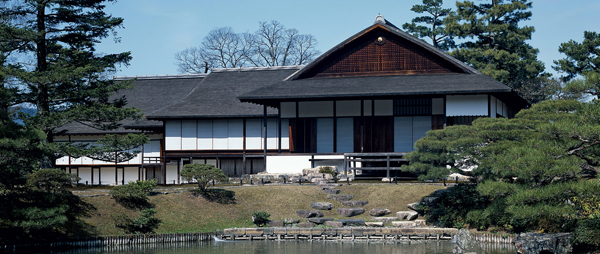
Which design aspect of the Katsura Imperial Villa can be considered most emblematic of Japanese residential architecture?
A) Ornamentation that emphasizes owner's wealth
B) Open doors create harmonious integration with garden
C) Bright primary colors for walls and beams
D) Large open-plan interior areas

Which design aspect of the Katsura Imperial Villa can be considered most emblematic of Japanese residential architecture?
A) Ornamentation that emphasizes owner's wealth
B) Open doors create harmonious integration with garden
C) Bright primary colors for walls and beams
D) Large open-plan interior areas

Unlock Deck
Unlock for access to all 50 flashcards in this deck.
Unlock Deck
k this deck
24

Which of the following aspects of this painting does NOT reflect Western influences?
A) Oil paint
B) Abstract rendering of garment
C) Realistic facial detailing
D) Accurate recording of coiffure

Which of the following aspects of this painting does NOT reflect Western influences?
A) Oil paint
B) Abstract rendering of garment
C) Realistic facial detailing
D) Accurate recording of coiffure

Unlock Deck
Unlock for access to all 50 flashcards in this deck.
Unlock Deck
k this deck
25
Which of the following was a renowned tea master and teahouse designer?
A) Sesshu Toyo
B) Suzuki Harunobu
C) Sen No Rikyu
D) Kenzo Tange
A) Sesshu Toyo
B) Suzuki Harunobu
C) Sen No Rikyu
D) Kenzo Tange

Unlock Deck
Unlock for access to all 50 flashcards in this deck.
Unlock Deck
k this deck
26
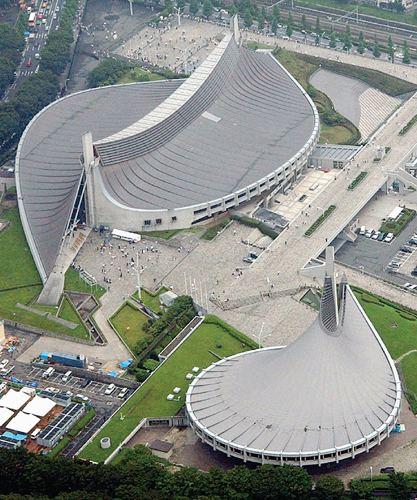
In what period were the Japanese Olympic stadiums built?
A) Edo
B) Meiji
C) Showa
D) Modern

In what period were the Japanese Olympic stadiums built?
A) Edo
B) Meiji
C) Showa
D) Modern

Unlock Deck
Unlock for access to all 50 flashcards in this deck.
Unlock Deck
k this deck
27
During which period were nishiki-e, or brocade, pictures created?
A) Showa
B) Muromachi
C) Edo
D) Momoyama
A) Showa
B) Muromachi
C) Edo
D) Momoyama

Unlock Deck
Unlock for access to all 50 flashcards in this deck.
Unlock Deck
k this deck
28
Karesansui (dry-landscape) gardens were helpful for meditation, which is a facet of which religion?
A) Pure Land Buddhism
B) Zen Buddhism
C) Hinduism
D) Confucianism
A) Pure Land Buddhism
B) Zen Buddhism
C) Hinduism
D) Confucianism

Unlock Deck
Unlock for access to all 50 flashcards in this deck.
Unlock Deck
k this deck
29
Honami Koetsu was a talented Edo calligrapher and ceramicist who also designed which of the following?
A) Portrait sculpture
B) Dry gardens
C) Country villas
D) Lacquered objects
A) Portrait sculpture
B) Dry gardens
C) Country villas
D) Lacquered objects

Unlock Deck
Unlock for access to all 50 flashcards in this deck.
Unlock Deck
k this deck
30
Kano painters of the Momoyama period were asked to create folding screens and sliding panels for structures built for which group?
A) European traders
B) Jesuit monks
C) Warlords
D) Zen philosophers
A) European traders
B) Jesuit monks
C) Warlords
D) Zen philosophers

Unlock Deck
Unlock for access to all 50 flashcards in this deck.
Unlock Deck
k this deck
31
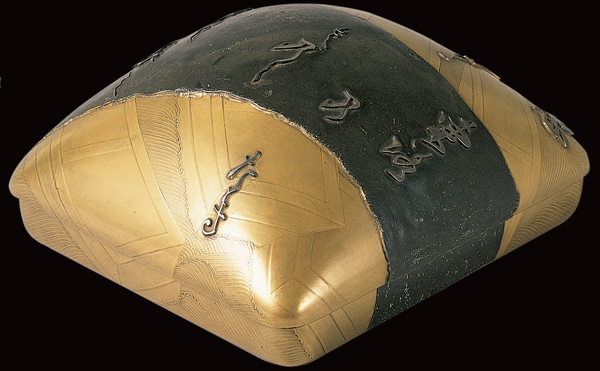
This lacquer writing box Boat Bridge by Honami Koetsu is an example of which style?
A) Nihonga
B) Haboku
C) Rinzai school
D) Rinpa School

This lacquer writing box Boat Bridge by Honami Koetsu is an example of which style?
A) Nihonga
B) Haboku
C) Rinzai school
D) Rinpa School

Unlock Deck
Unlock for access to all 50 flashcards in this deck.
Unlock Deck
k this deck
32
Which major artistic genre was introduced in Japan in the late 19th century?
A) Goldworking
B) Portrait sculpture
C) Woodcarving
D) Oil painting
A) Goldworking
B) Portrait sculpture
C) Woodcarving
D) Oil painting

Unlock Deck
Unlock for access to all 50 flashcards in this deck.
Unlock Deck
k this deck
33
Which artist designed the print series entitled Eight Views of the Parlor ?
A) Kitagawa Utamaro
B) Suzuki Harunobu
C) Katsushika Hokusai
D) Takahashi Yuichi
A) Kitagawa Utamaro
B) Suzuki Harunobu
C) Katsushika Hokusai
D) Takahashi Yuichi

Unlock Deck
Unlock for access to all 50 flashcards in this deck.
Unlock Deck
k this deck
34
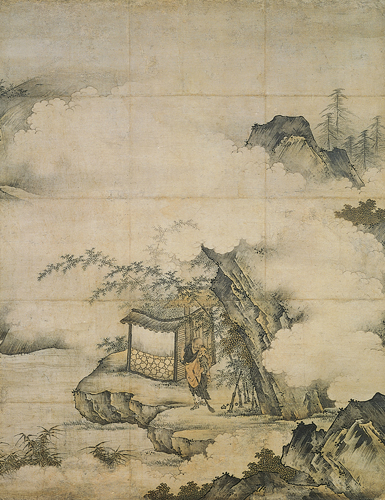
The precision of the brushwork and the ink lines in Zen Patriarch Xiangyen Zhixian Sweeping with a Broom marks it as a product of which school of painting?
A) Rinzai school
B) Kano School
C) Rinpa School
D) Soto school

The precision of the brushwork and the ink lines in Zen Patriarch Xiangyen Zhixian Sweeping with a Broom marks it as a product of which school of painting?
A) Rinzai school
B) Kano School
C) Rinpa School
D) Soto school

Unlock Deck
Unlock for access to all 50 flashcards in this deck.
Unlock Deck
k this deck
35
The misty rendering and near formlessness of Hasegawa Tohaku's Pine Forest invokes which precept of Zen Buddhism?
A) Sense of incompleteness before enlightenment
B) Illusory nature of mundane reality
C) Symbolic withdrawal from the ordinary world
D) The tranquility reached in old age
A) Sense of incompleteness before enlightenment
B) Illusory nature of mundane reality
C) Symbolic withdrawal from the ordinary world
D) The tranquility reached in old age

Unlock Deck
Unlock for access to all 50 flashcards in this deck.
Unlock Deck
k this deck
36
Which of the following is an accurate description of Shino ware?
A) Elaborate forms and smooth surfaces
B) Elaborate forms and rough surfaces
C) Simple forms and smooth surfaces
D) Simple forms and rough surfaces
A) Elaborate forms and smooth surfaces
B) Elaborate forms and rough surfaces
C) Simple forms and smooth surfaces
D) Simple forms and rough surfaces

Unlock Deck
Unlock for access to all 50 flashcards in this deck.
Unlock Deck
k this deck
37
Which of the following would NOT be a subject of the works, referred to as ukiyo-e, produced by the urban counterculture of the Edo period?
A) Sumo wrestling ring
B) Kabuki theater
C) Court ceremony
D) Bathhouses
A) Sumo wrestling ring
B) Kabuki theater
C) Court ceremony
D) Bathhouses

Unlock Deck
Unlock for access to all 50 flashcards in this deck.
Unlock Deck
k this deck
38
What sociopolitical reality of the Momoyama period determined the design of the White Heron Castle?
A) Territorial conflict
B) Portuguese trade
C) Famine and drought
D) Rise of Zen Buddhism
A) Territorial conflict
B) Portuguese trade
C) Famine and drought
D) Rise of Zen Buddhism

Unlock Deck
Unlock for access to all 50 flashcards in this deck.
Unlock Deck
k this deck
39
Which artist designed the woodblock print Plum Estate, Kameido , which inspired the European painter Vincent van Gogh with its coloration and abstract quality?
A) Takahashi Yuichi
B) Katsushika Hokusai
C) Yosa Buson
D) Ando Hiroshige
A) Takahashi Yuichi
B) Katsushika Hokusai
C) Yosa Buson
D) Ando Hiroshige

Unlock Deck
Unlock for access to all 50 flashcards in this deck.
Unlock Deck
k this deck
40
Which early Japanese literati painter was famed for the lyricism of both his haiku poetry and his painting?
A) Ande Hiroshige
B) Sesshu Toyo
C) Yosa Buson
D) Suzuki Harunobu
A) Ande Hiroshige
B) Sesshu Toyo
C) Yosa Buson
D) Suzuki Harunobu

Unlock Deck
Unlock for access to all 50 flashcards in this deck.
Unlock Deck
k this deck
41
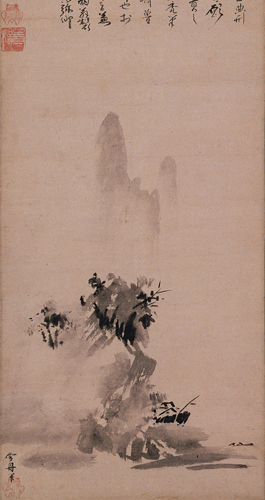
Which artist painted this Muromachi landscape?
A) Kano Motonobu
B) Sesshu Toyo
C) Tawaraya Sotatsu
D) Ogata Korin

Which artist painted this Muromachi landscape?
A) Kano Motonobu
B) Sesshu Toyo
C) Tawaraya Sotatsu
D) Ogata Korin

Unlock Deck
Unlock for access to all 50 flashcards in this deck.
Unlock Deck
k this deck
42
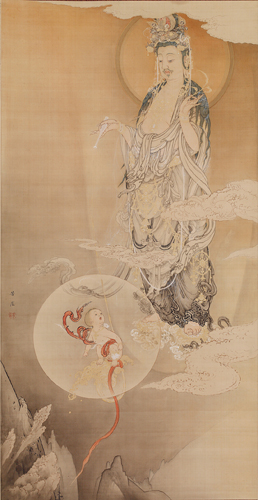
What is the subject of this nihonga painting by Kano Hogai?
A) The enlightenment of the Buddha
B) The creation of man
C) The birth of the Buddha
D) The dawn of human wisdom

What is the subject of this nihonga painting by Kano Hogai?
A) The enlightenment of the Buddha
B) The creation of man
C) The birth of the Buddha
D) The dawn of human wisdom

Unlock Deck
Unlock for access to all 50 flashcards in this deck.
Unlock Deck
k this deck
43
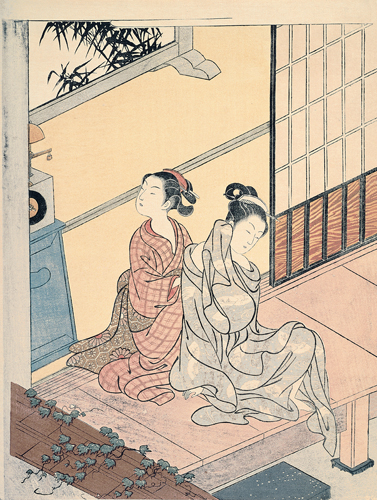
What was used to create the colors in Japanese ukiyo-e prints such as this one?
A) Mineral pigments
B) Plant dyes
C) Synthetic dyes
D) Insect and fish dyes

What was used to create the colors in Japanese ukiyo-e prints such as this one?
A) Mineral pigments
B) Plant dyes
C) Synthetic dyes
D) Insect and fish dyes

Unlock Deck
Unlock for access to all 50 flashcards in this deck.
Unlock Deck
k this deck
44
Which two Japanese printmakers were acclaimed for landscapes?
A) Hamada Shoji and Kano Hogai
B) Kitagawa Utamaro and Katsushika Hokusai
C) Suzuki Harunobu and Ando Hiroshige
D) Ando Hiroshige and Katsushika Hokusai
A) Hamada Shoji and Kano Hogai
B) Kitagawa Utamaro and Katsushika Hokusai
C) Suzuki Harunobu and Ando Hiroshige
D) Ando Hiroshige and Katsushika Hokusai

Unlock Deck
Unlock for access to all 50 flashcards in this deck.
Unlock Deck
k this deck
45
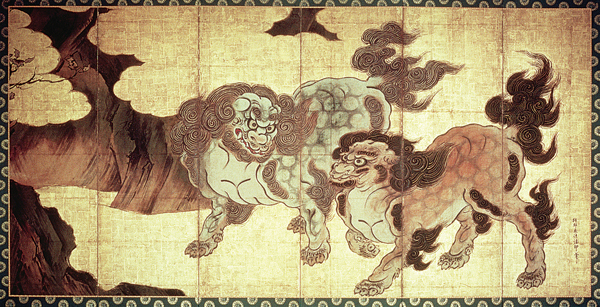
What animal is depicted on this Momoyama period six-panel screen?
A) Bull
B) Dog
C) Griffin
D) Lion

What animal is depicted on this Momoyama period six-panel screen?
A) Bull
B) Dog
C) Griffin
D) Lion

Unlock Deck
Unlock for access to all 50 flashcards in this deck.
Unlock Deck
k this deck
46

Which leading figure in the folk art movement of modern Japan created this work?
A) Jiro Yoshihara
B) Hamada Shoji
C) Okakura Kakuzo
D) Kano Hogai

Which leading figure in the folk art movement of modern Japan created this work?
A) Jiro Yoshihara
B) Hamada Shoji
C) Okakura Kakuzo
D) Kano Hogai

Unlock Deck
Unlock for access to all 50 flashcards in this deck.
Unlock Deck
k this deck
47
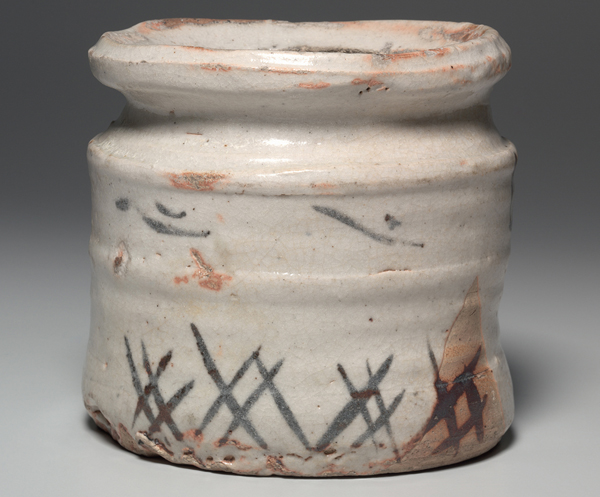
What term is used to describe this tea-ceremony water jar of the Momoyama period?
A) Tokonoma
B) Mingei
C) Byobu
D) Kogan

What term is used to describe this tea-ceremony water jar of the Momoyama period?
A) Tokonoma
B) Mingei
C) Byobu
D) Kogan

Unlock Deck
Unlock for access to all 50 flashcards in this deck.
Unlock Deck
k this deck
48
Six-panel paintings used as sliding doors are referred to by which Japanese term?
A) Yoga
B) Fusama
C) Chanoyu
D) Daimyo
A) Yoga
B) Fusama
C) Chanoyu
D) Daimyo

Unlock Deck
Unlock for access to all 50 flashcards in this deck.
Unlock Deck
k this deck
49
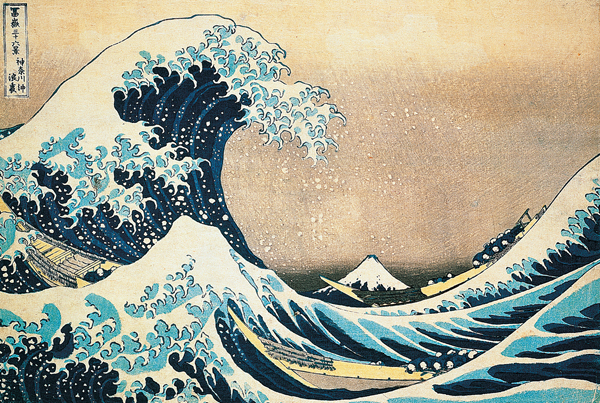
In what medium did Katsushika Hokusai create The Great Wave off Kanagawa ?
A) Engraving
B) Woodblock
C) Etching
D) Watercolor

In what medium did Katsushika Hokusai create The Great Wave off Kanagawa ?
A) Engraving
B) Woodblock
C) Etching
D) Watercolor

Unlock Deck
Unlock for access to all 50 flashcards in this deck.
Unlock Deck
k this deck
50
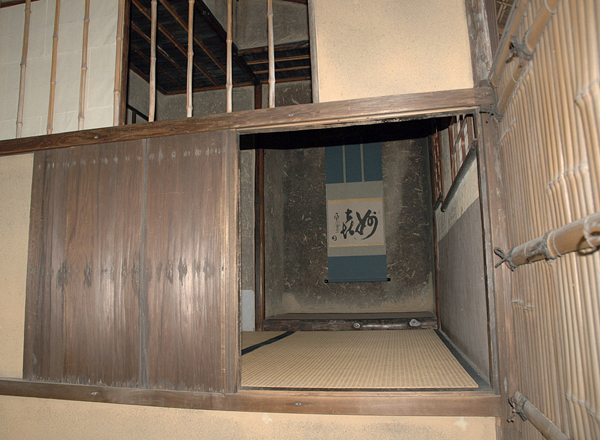
In which period was the Taian teahouse built at the Myokian temple in Kyoto?
A) Muromachi
B) Meiji
C) Edo
D) Momoyama

In which period was the Taian teahouse built at the Myokian temple in Kyoto?
A) Muromachi
B) Meiji
C) Edo
D) Momoyama

Unlock Deck
Unlock for access to all 50 flashcards in this deck.
Unlock Deck
k this deck



